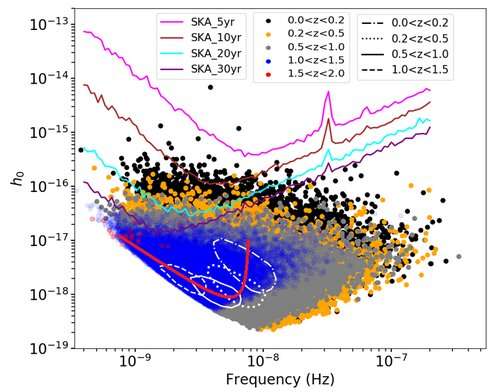#Supermassive binary black hole hunter: SKA pulsar timing array
“#Supermassive binary black hole hunter: SKA pulsar timing array”

Recently, researchers from the National Astronomical Observatory of the Chinese Academy of Sciences quantified the potential of gravitational wave detection in the era of the Square Kilometer Array (SKA). The study was published in Physical Review D.
This new calculation demonstrates, for the first time, that even a small number of high-quality millisecond pulsars (about 20) monitored by SKA can deliver valuable information about the redshift evolution of supermassive black hole binaries (SMBBH).
Supermassive black holes are commonly found in the center of galaxies and evolve with their hosts. SMBBHs are thus expected to exist in close galaxy pairs. However, none has been unequivocally detected.
The research team carried out semi-analytical numerical simulation to estimate the number of detectable SMBBHs with SKA Pulsar Timing Array (SKA-PTA).
Based on infrared galaxy samples and statistical assumptions of the SMBBH population, the team calculated their low-frequency gravitational wave characteristics at different redshifts.
SKA is a multi-purpose radio telescope with a collecting area approaching 1 million square meters, and thus holds great potential for detecting nanohertz gravitational waves.
Different from the idea that hundreds of pulsars are commonly assumed to be necessary in previous work, the new calculation demonstrates that a SKA-PTA consisting of merely ~20 pulsars is capable of achieving gravitational wave detection within five years of operation and growing to a detection rate of more than 100 SMBBHs/yr after about 10 years.
Within 30 years of operation, about 60 individual SMBBHs detection with z 4 with z
The substantial number of expected detections and their evolution with redshift discernable by SKA-PTA will make SKA a significant tool for studying evolution of SMBBHs and their host galaxies.
More information:
Yi Feng et al. Supermassive binary black hole evolution can be traced by a small SKA pulsar timing array, Physical Review D (2020). DOI: 10.1103/PhysRevD.102.023014
Supermassive binary black hole hunter: SKA pulsar timing array (2020, July 9)
retrieved 9 July 2020
from https://phys.org/news/2020-07-supermassive-binary-black-hole-hunter.html
This document is subject to copyright. Apart from any fair dealing for the purpose of private study or research, no
part may be reproduced without the written permission. The content is provided for information purposes only.
If you want to read more Like this articles, you can visit our Science category.
if you want to watch Movies or Tv Shows go to Dizi.BuradaBiliyorum.Com for forums sites go to Forum.BuradaBiliyorum.Com




